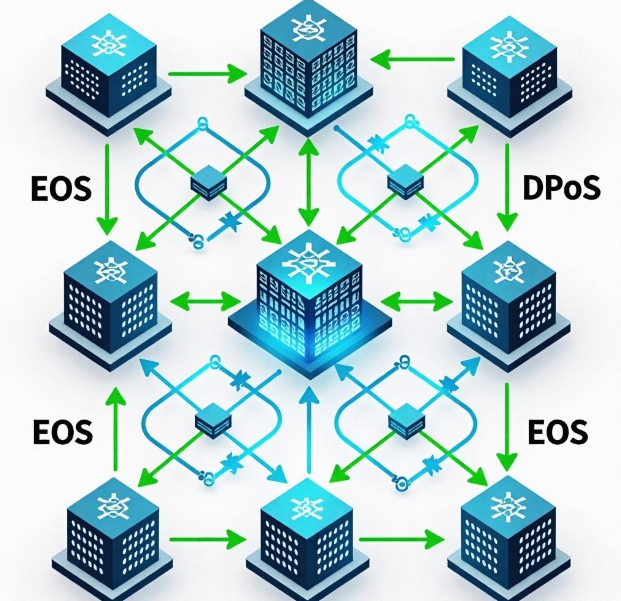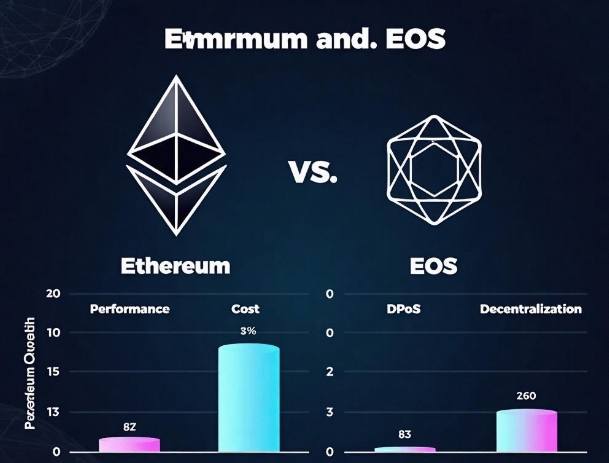How to Choose a DApp Development Platform: Ethereum vs. EOS Comparison
- latest articles
- 1.DApp Development & Customization: Merging Diverse Market Needs with User Experience 2.Analysis of the Core Technical System in DApp Project Development 3.How to achieve cross-chain interoperability in Web3 projects? 4.How does the tokenization of points reconstruct the e-commerce ecosystem? 5.How to Set and Track Data Metrics for a Points Mall? 6.What is DApp Development? Core Concepts and Technical Analysis 7.Inventory of commonly used Web3 development tools and usage tips 8.Development of a Distribution System Integrated with Social E-commerce 9.Six Key Steps for Businesses to Build a Points Mall System 10.What is DApp Development? A Comprehensive Guide from Concept to Implementation
- Popular Articles
- 1.Future Trends and Technology Predictions for APP Development in 2025 2.Analysis of the DeFi Ecosystem: How Developers Can Participate in Decentralized Finance Innovation 3.From Zero to One: How PI Mall Revolutionizes the Traditional E-commerce Model 4.DAPP Development | Best Practices for Professional Customization and Rapid Launch 5.Recommended by the Web3 developer community: the most noteworthy forums and resources 6.From Cloud Computing to Computing Power Leasing: Building a Flexible and Scalable Computing Resource Platform 7.How to Develop a Successful Douyin Mini Program: Technical Architecture and Best Practices 8.Shared Bike System APP: The Convenient Choice in the Era of Smart Travel 9.How to Create a Successful Dating App: From Needs Analysis to User Experience Design 10.From Design to Development: The Complete Process of Bringing an APP Idea to Life
With the rapid development of blockchain technology, decentralized applications (DApps) have become an important component of the digital economy. The rise of DApps not only breaks the centralized architecture of traditional applications but also provides more possibilities for various innovative services. As a DApp developer, choosing a suitable development platform is crucial. Currently, Ethereum and EOS are the two most popular DApp development platforms, each with unique technical advantages and ecosystems. This article will compare these two platforms to help developers understand how to choose the right DApp development platform for their needs.
1. What is a DApp?
A Decentralized Application (DApp) is an application built on blockchain technology. Unlike traditional centralized applications, DApps do not rely on centralized servers or databases for data management and storage. Their core characteristics are decentralization, open-source nature, and smart contract-driven functionality.
Key features of DApps:
Decentralization: Data is not managed by a single server but is distributed and stored on the blockchain.
Open Source: The code is typically public, allowing any developer to view, modify, and contribute.
Smart Contracts: DApps achieve trustless and automated functionality through smart contracts.
2. Introduction to Ethereum
Ethereum is one of the earliest smart contract platforms and currently one of the most mature blockchain platforms. It provides an open-source blockchain architecture that allows developers to build DApps on it and implement automated, decentralized operations through smart contracts.
1. Features of Ethereum
Smart Contracts: Ethereum's smart contract functionality provides strong support for decentralized applications, enabling developers to write complex business logic and execute it automatically through contracts.
Extensive Developer Community: As the earliest smart contract platform, Ethereum has a large developer community that offers abundant development tools, documentation, and technical support.
Decentralization: Ethereum's network consists of thousands of nodes worldwide, ensuring decentralization and security.
Transaction Fees: Ethereum's transaction fees (Gas) are relatively high, especially during network congestion, when both confirmation times and fees can increase significantly.
2. Disadvantages of Ethereum
Scalability Issues: Ethereum's current blockchain network has limited processing capacity, handling only about 30 transactions per second, making it difficult to meet high-frequency transaction demands.
High Transaction Fees: As network usage increases, transaction fees continue to rise, posing a significant burden for both developers and users.
High Energy Consumption: Ethereum uses the Proof of Work (PoW) consensus mechanism, which means its energy consumption is relatively high and has certain environmental impacts.
3. Introduction to EOS
EOS is a blockchain platform launched by Block.one, aiming to address the scalability and high fee issues faced by Ethereum. EOS adopts the Delegated Proof of Stake (DPoS) consensus mechanism and claims to support millions of transactions per second.
1. Features of EOS
High Throughput: One of EOS's design goals is high throughput. Through the DPoS mechanism, EOS can achieve higher transaction speeds, theoretically processing over 1,000 transactions per second, and even reaching millions of transactions.
Zero Transaction Fees: Unlike Ethereum's Gas fees, the EOS platform has almost no transaction fees, allowing users to transact without incurring costs, greatly enhancing the user experience.
Flexible Permission Management: EOS provides a flexible permission management mechanism, allowing developers to set permissions according to their needs, ensuring decentralized management of DApps.
Upgradability: EOS allows DApp developers to upgrade and modify smart contracts without redeployment, offering great convenience to developers.
2. Disadvantages of EOS
Centralization Issues: EOS uses the DPoS consensus mechanism, where transactions are confirmed by a small number of "super nodes," leading to a lower degree of network decentralization. Although EOS claims to be decentralized, many users consider it relatively centralized in practice.
Governance Issues: EOS's governance mechanism is somewhat controversial. Since most voting power is held by a few super nodes, ordinary users have limited influence, which may lead to unfair platform governance.
Weaker Development Ecosystem: Although EOS provides strong technical support, its developer community is smaller compared to Ethereum, and its ecosystem is less mature.
4. Comparison Between Ethereum and EOS
When choosing a DApp development platform, developers need to make a decision based on their project's requirements and goals. Below, we compare Ethereum and EOS across multiple dimensions.
1. Performance and Scalability
Ethereum: Ethereum has slower transaction speeds and processes fewer transactions per second, typically around 30. During network congestion, transaction fees can rise sharply, and confirmation times may be delayed.
EOS: EOS's high throughput is one of its biggest advantages. Its DPoS consensus mechanism can support millions of transactions per second with no transaction fees, making EOS an ideal platform for high-performance, high-frequency DApps.
2. Developer Ecosystem
Ethereum: As the earliest smart contract platform, Ethereum has the largest global developer community. Developers can leverage abundant development tools, documentation, and tutorials to build DApps. Its extensive developer base makes Ethereum's ecosystem very mature.
EOS: Although EOS has a developer community, its development ecosystem is smaller compared to Ethereum. Developers may encounter resource shortages, especially in terms of tool and documentation support.
3. Cost
Ethereum: Ethereum's transaction fees (Gas) fluctuate with network usage, especially during peak periods, when fees can rise sharply. For small DApp projects, this may impose significant cost pressure.
EOS: EOS employs a zero-transaction-fee mechanism, allowing users and developers to avoid high Gas fees. This gives EOS a significant cost advantage.
4. Decentralization
Ethereum: Ethereum uses the Proof of Work (PoW) mechanism, ensuring a high degree of decentralization, with thousands of nodes worldwide participating in verification and maintenance.
EOS: EOS uses the DPoS mechanism, which, while providing higher transaction speeds and throughput, results in a lower degree of network decentralization. A small number of super nodes hold significant voting power, which may affect the platform's decentralization in some cases.
5. Governance Mechanism
Ethereum: Ethereum's governance mechanism is more traditional, relying on consensus among developers and the community. Its strong decentralization means platform updates and upgrades require broad community participation.
EOS: EOS's governance mechanism relies on the election and decision-making of super nodes. While this mechanism improves efficiency, it has also sparked some decentralization controversies.
5. How to Choose a DApp Development Platform?
When choosing a DApp development platform, developers need to make decisions based on their project's actual requirements. Here are some suggestions:
DApps with High Performance Requirements: If your DApp needs to handle a large volume of transactions or high-frequency transactions, EOS may be a better choice due to its higher transaction throughput and speed.
DApps with High Decentralization Requirements: If you prioritize decentralization and are willing to accept slower transaction speeds and higher fees, Ethereum may better suit your needs.
Development Ecosystem and Tool Support: If you need extensive developer community support and rich development tools, Ethereum is undoubtedly the better choice.
Cost Considerations: If you want to avoid high transaction fees, EOS's zero-transaction-fee model will provide lower costs.
6. Conclusion
Ethereum and EOS each have distinct features and advantages. Choosing the right development platform depends on your project's needs. If your project emphasizes decentralization and community support, Ethereum may be a better choice. If your project requires high throughput, low transaction fees, and can tolerate some degree of centralization, EOS is undoubtedly a platform worth considering.
In the future, as technology advances, more blockchain platforms may emerge. Developers need to continuously monitor the trends in emerging technologies and choose the platform that best fits their needs for development.
-

DApp Development & Customization: Merging Diverse Market Needs with User Experience
As blockchain technology matures and becomes more widespread, decentralized appl···
-

Analysis of the Core Technical System in DApp Project Development
With the rapid development of blockchain technology, decentralized applications ···
-

What is DApp Development? Core Concepts and Technical Analysis
With the rapid development of blockchain technology, decentralized applications ···

 Blockchain
Blockchain












